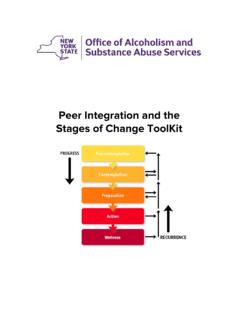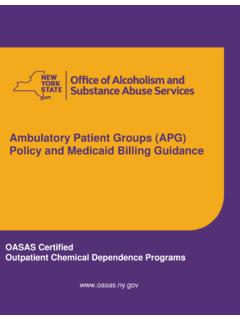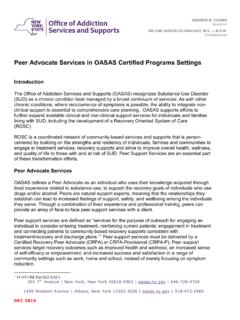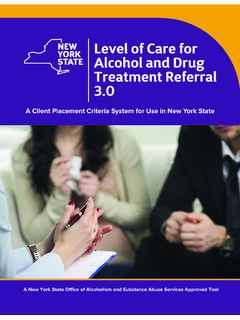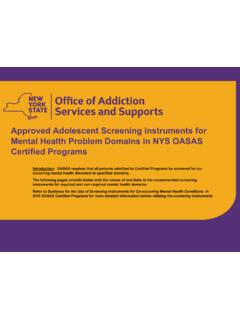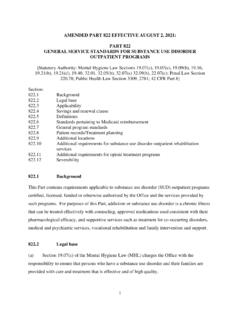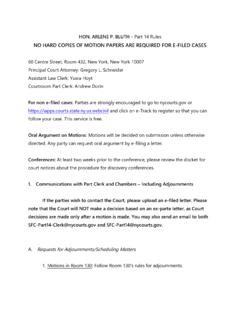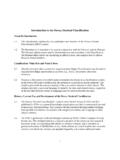Transcription of Person-Centered Care Guidance - Office of Addiction ...
1 ANDREW M. CUOMO GovernorARLENE GONZ LEZ-S NCHEZ, , Commissioner1 4 5 0 W e s t e r n A v e n u e | A l b a n y, N e w Y o r k 1 2 2 0 3-3 5 2 6 | o a s a s . n y. g o v | 5 1 8-473-3 4 6 0 Person-Centered Care Guidance for OASAS Certified Programs Office of Addiction Services and Supports (OASAS) is issuing this Guidance to address questions brought to OASAS from providers of Addiction treatment. Promoting individual choice and Person-Centered care is consistent with the current standard for Addiction treatment for substance use disorders (SUD). The following Guidance intends to support providers certified by OASAS with the general principals and expectations essential to providing a Person-Centered care model of service delivery. Person-Centered treatment plans are developed using an individual s own language toidentify treatment goals.
2 Plans should reflect the individual s values, culture and beliefs. Person-Centered treatment planning includes working with individuals who may havetreatment goals other than abstinence. This includes reducing use and minimizing riskassociated with substance use pattern. Individual goal setting should reflect shared decision making and informed individual seeking services should be informed of the comprehensive array ofavailable treatment options. The individual should make an informed choice regardingmedication and behavioral approaches to treatment. The multidisciplinary treatment team maintains a professional role by informingtreatment planning and assuming ultimate responsibility for the plan. Person-Centered treatment is evidence-based, strength-based and Person-Centered Principles into PracticePerson- centered treatment starts with a plan that is created by using the individual s own language and is consistent with values, culture, beliefs and goals.
3 Treatment planning begins at the first conversation with an individual about an Addiction issue. It is important to support an individual s personal motivation to seek treatment and assure treatment planning remains non-judgmental and free from bias. Using a person s own words in identifying what elements of their use they find problematic and prioritization of their main goals helps to align the treatment plan to the person. For example: Client: I really need work. If that were to happen, I don t think my using would be as much of an issue for everyone. I use mostly because I am bored. ANDREW M. CUOMO GovernorARLENE GONZ LEZ-S NCHEZ, , Commissioner1 4 5 0 W e s t e r n A v e n u e | A l b a n y, N e w Y o r k 1 2 2 0 3-3 5 2 6 | o a s a s . n y. g o v | 5 1 8-473-3 4 6 0 Counselor: Your number one goal is to get a job. We can start by making a plan that you think will be successful in getting you to that goal.
4 What do you think? Goal planning does not need to be complex, it should be straight forward and developed collaboratively alongside the client engaged in care. Completing the plan with the client in session has several benefits. Taking advantage of a shared therapeutic space ensures that the you both counselor and client use shared decision making when reaching an agreement, and that the plan is consistent with how the client sees the problem, actions towards resolution and success. Goals answer the basic questions What do you want? Objectives answer - How will you achieve that? What steps will you take? When will you take them? Who will help you? An initial plan may consist of a single goal and one or two steps that the individual and the treatment team are taking to meet the goal. Person-Centered care includes treatment plans that support the individual s own goals.
5 People arrive in treatment for many different reasons, and present at various stages of change, with many different expectations, aspirations and theories about how they arrived at the place they are. They have different ideas of what successful treatment would look like for them, including the steps they believe will help them get there. The first step of any assessment is to listen carefully to what the person is saying and to skillfully work with the person to a mutual understanding of the problem the person has presented, the outcome that is desired and some initial steps to begin developing the roadmap to those outcomes. Person-Centered care includes a menu of treatment options. Goals are always in the direction of positive change and may include: improving functioning, increasing emotional regulation, building social connectedness, reducing or eliminating substance use and individualized goal attainment (find employment, leave or find a relationship, complete degree, etc).
6 A Person-Centered interview focuses on what the person is saying and their framing of the problems and potential solutions. The counselor is active in guiding, reframing, raising discrepancies, offering compassion and hope by taking what the person is saying and translating that to a plan of action that the person recognizes as their own. Recovery Supports that provide peer to peer, recreation, social connectedness through a variety of options to a wide range of individuals are included in the plan. Person- centered care includes harm reduction options for individuals who wish to continue use without seeking treatment but want to reduce risk of transmission of illness secondary to use, avoid overdose, test a sample of substance, learn ways of living healthier, gain support and reduce social isolation. Most communities have harm reduction programs that provide these services when an individual chooses not to enter treatment.
7 At the consent of the individual engaged in care, families and significant others are encouraged to engage in treatment to support the individual and receive support for their own recovery. This can be done through family treatment sessions where family can learn skills to support their loved one while establishing an open line of therapeutic communication. ANDREW M. CUOMO GovernorARLENE GONZ LEZ-S NCHEZ, , Commissionerand continue to move toward healthier behaviors and improvement in functioning. Individuals who are affected by a someone s Addiction are also welcomed to treatment, even if the person who is suffering from Addiction is not willing or able to attend treatment. Individuals should be informed of a wide array of available treatment options to make an informed choice about medication and behavioral approaches to treatment. People seeking treatment may know little about treatment options.
8 Even if they have experienced treatment in the past, they may only be aware of one approach. The most important part of a Person-Centered care interview is listening to what the person is saying about their experience and providing options that match what the person is presenting. For example, a client comes to treatment at the urging of a family member after an overdose. They report that they believe they are better now but came to satisfy the concerns of the family. Although this person has been in outpatient sessions and has seen a therapist, they are not aware of the medication options or peer supports that could be available. After asking permission to provide more information, the person agrees to hear more. After being presented with comprehensive information on medication and behavioral options, the client reveals that they have relapsed many times after having made promises and that they are just now becoming aware of the power of urges and cravings to use.
9 This helps the person to see the problem in a different way and guides the plan toward better addressing urges and cravings through medication and cognitive strategies accompanied by meeting with a peer to help build recovery support. The multidisciplinary treatment team maintains professional role in informing treatment planning and retains responsibility for the plan. The counselor and treatment team share knowledge and recommendations with the individual and make recommendations and provide input into the plan. This includes making a clinical assessment of risks to the individual and communicating clinical assessment and recommendations in terms that are understandable. Risk of substance use pattern should be communicated to individuals who are using substances. Recommendations about the best level of care as well as the recommendations about medication and behavioral treatments should also be communicated.
10 The individual should retain autonomy and self-determination within treatment and may or may not follow each of the recommendations of the treatment provider. This should never be the sole reason for dismissal from a treatment program. Providers should always assess the risks to the individual of current course of treatment and of treatment response, balanced with the benefits. For example, someone who continues to use substances, and is responding well to medication for opioid use disorder. The client should be helped to reduce risks as much as possible, and all efforts should be documented, however, the medication should not be discontinued as it is clearly a benefit. The provider/ treatment team should encourage continued engagement in care and continue to work towards improvement. 1450 W estern Avenue | Albany, New York 12203-3526 | | 518-473-3460 ANDREW M.
